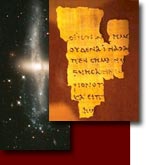| Site Map | Contacts | Links | Newsletter | |
Old Testament:
Hebrew Text
The basic Hebrew text is called the Masoretic Text (MT), which is named after a group of scribes in the ninth century that preserved the text and added vowels and punctuation marks. The original Hebrew just had consonants, but a few consonants functioned as vowels. No one would know how to pronounce the Hebrew words unless vowel marks were added. This is a great help in understanding the text. (Hebrew Bible)
There were three different tasks of copying the OT. The Sopherim wrote the consonantal text. The Nakdanim added the vowel points and accents. The Masoretes added the marginal notes. An example is the Kethib (what is written) and Qere (what should be read). There are over 1,300 of these. The vowels of the Qere were written in the text of the Kethib. There are three different systems of vowel pointing, the Babylonian, Palestinian and Tiberian which the Masoretes created. The marginal notes called Masora were mainly written in Aramaic and were like a concordance.
Before the discovery of the Dead Sea Scrolls the Nash Papyrus was the oldest known witness to the OT which dated to the first or second century AD. It contained the decalogue. The second oldest were the Cairo Geniza fragments (about 200,000) which date to the fifth century AD (See Princeton Geniza Project). Most of these are in the Cambridge University Library and the Bodleian Library at Oxford. The oldest known text of the OT was discovered in 1979 in tombs across the Hinnom valley from Jerusalem. The text is the benediction of Aaron (Numbers 6:24-26) written on a silver amulet from the 7th century BC (Hoerth 1998, 386).
The oldest surviving manuscript of the complete Bible is the Codex Leningradensis which dates to 1008 AD. A Facsimile edition of this great codex is now available (Leningrad Codex 1998, Eerdmans for $255). The BHS (Biblia Hebraica Stuttgartensia) follows this codex. The most comprehensive collection of old Hebrew manuscripts is in the Russian Public Library in St. Petersburg formerly called Leningrad. Another important text is the Aleppo Codex which is now in Jerusalem. The HUB (Hebrew University Bible) follows the Aleppo Codex. The Isaiah and Jeremiah editions are now available. For a more detailed study see The Text of the Old Testament by Ernst Wurthwein and Textual Criticism: Recovering the Text of the Hebrew Bible by P. Kyle McCarter, Jr.
